

Visual Culture and the New Zealand Curriculum - Issue-based Assemblage Sculpture. Writer: Sam Cunnane Media: Mixed MediaCurriculum Level: 5Year Level: 10Duration: 9 periods Assessment: Tchr & Peer Images shown in this unit and supporting information are sourced from, and can be accessed through Digistore 'No nukes in the Pacific' poster, 1984 Acknowledgements: 'Asiasi II', 2000 'Pisupo lua afe' (Corned beef 2000), 1994 This resource is offered as an example of a unit that engages with the "front end" of The New Zealand Curriculum (2007) - considering Vision, Principles, Values, and Key Competencies, as well as Achievement Objectives.

Artists with Issues. Designed in Hackney: chandeliers by Stuart Haygarth. Designed in Hackney: these chandeliers by Hackney designer Stuart Haygarth were painstakingly assembled from found objects like discarded spectacles, plastic bottles or party-poppers.
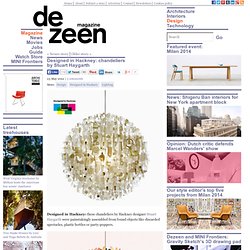
Haygarth has been making chandeliers since 2005, when he first presented Tide (above), made of debris washed up on Dungeness Beach in southeast England. Optical (above) is made of 3,000 unwanted prescription spectacle lenses and was created for the Trash Luxe exhibition at Liberty in London in 2007, which was curated by Dezeen editor-in-chief Marcus Fairs. Later in 2007 Haygarth made Drop (above), a water droplet-shaped chandelier made of discarded plastic water bottles. Read more about Drop here and scroll down for an interview we filmed with Haygarth at Design Miami in 2007, where he presented the piece.
The chandelier above, made of spectacle frames, was created for an exhibition held at the Haunch of Venison gallery in London in 2009. Strand installation by Stuart Haygarth at Macmillan Cancer Centre. Combs, lighters and babies' dummies are among the hundreds of objects found washed up on British beaches and then hung in the atrium of a new London cancer centre by designer Stuart Haygarth.

Stuart Haygarth was asked by University College London Hospitals NHS Foundation Trust to create a permanent installation for a new Macmillan cancer centre in central London. Called Strand, the artwork comprises hundreds of objects found during a 500-mile coastal walk from Gravesend in Kent to Land's End in Cornwall. The objects were categorised by colour and suspended from the hospital's atrium as if exploding outwards, an approach that Haygarth has used before to make chandeliers from debris such as spectacle lenses and plastic bottles.
"You can see from the collections of objects the variety is immense - an archive of mass production," Haygarth told Dezeen. Strand can be viewed between 9am and 5pm in the ground floor atrium of the Macmillan Cancer Centre, Huntley Street, London WC1E 6AG. Plastic Garbage Guarding the Museum by Luzinterruptus. Plastic carrier bags glow like lamps from within two skips that Spanish lighting designers Luzinterruptus have placed at the entrance to the Gewerbemuseum in northern Switzerland.
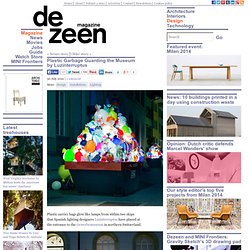
The designers selected the most brightly coloured bags from over 5000 collected from museum visitors and have filled each one with air as if it were a balloon. The installation, entitled Plastic Garbage Guarding the Museum, accompanies a four-month exhibition that looks at how the culture of using and throwing away plastic bags is representative of consumer society. The illuminated bags will remain outside the museum for the duration of the show, where their colours will fade and they will become increasingly dirty.
For the opening night the designers also filled a square outside the museum with more of the brightly lit carriers. Some were scattered on the ground as toys, while others were filled with helium and tethered on strings. The Oh, Plastiksack! Radioactive Control by Luzinterruptus. An army of 100 scarecrows dressed in glowing decontamination suits kept a sinister vigil over the Dockville Festival in Hamburg earlier this month.
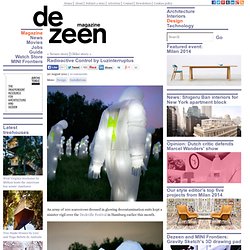
Installed by Spanish designers Luzinterruptus, the figures were supported in regular rows and adorned with nuclear symbols, blank faces and taped-up mouths. VHS Tape. VHS, Cassette Tape & Video Tape Art Zilvinas Kempinas - '02' Video tape loop, electric fan.
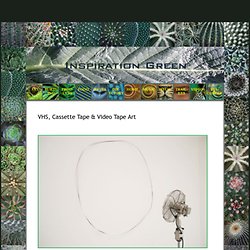
Installation Spencer Brownstone Gallery 2007. www.spencerbrownstonegallery.com Zilvinas Kempinas - 'Tube' Venice Biennial - 2009, magnetic tape, plywood. Zilvinas Kempinas - 'Columns' Vertically streched video tape, plywood, nails. Signs of Change : Nicole Dextras. Invasive Species : Nicole Dextras. Political art. 50 Stunning Political Artworks. Jan 26 2010 Graffiti artwork has been initially used by Ancient Greece, Roman Empire and Urban Gangs to mark their territory and also by some social and political purposes as well.
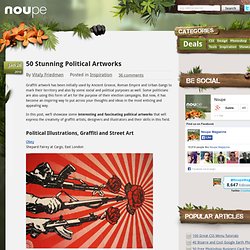
Some politicians are also using this form of art for the purpose of their election campaigns. But now, it has become an inspiring way to put across your thoughts and ideas in the most enticing and appealing way. In this post, we’ll showcase some interesting and fascinating political artworks that will express the creativity of graffiti artists, designers and illustrators and their skills in this field. Political Illustrations, Graffiti and Street Art ObeyShepard Fairey at Cargo, East London 1984 – not an instruction manual – other wallpaper 19908 – desktop nexus abstract Posted on a Door illustration series.
Political Art. What is political art?
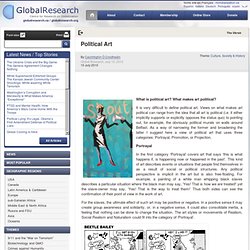
What makes art political? It is very difficult to define political art. Views on what makes art political can range from the idea that all art is political (i.e. it either implicitly supports or explicitly opposes the status quo) to pointing out, for example, the obviously political murals on walls around Belfast. As a way of narrowing the former and broadening the latter I suggest here a view of political art that uses three categories: Portrayal, Promotion, or Projection.
Portrayal In the first category ‘Portrayal’ covers art that says ‘this is what happens if, is happening now or happened in the past’. For the slaves, the ultimate effect of such art may be positive or negative. 35 Amazing Coffee Infographics Your Audience Will Love. Do you like coffee?

Something tells me that it is a rhetorical question :) Coffee is a cool generator of creative ideas, energy and inspiration. What is the first thing you do every morning?